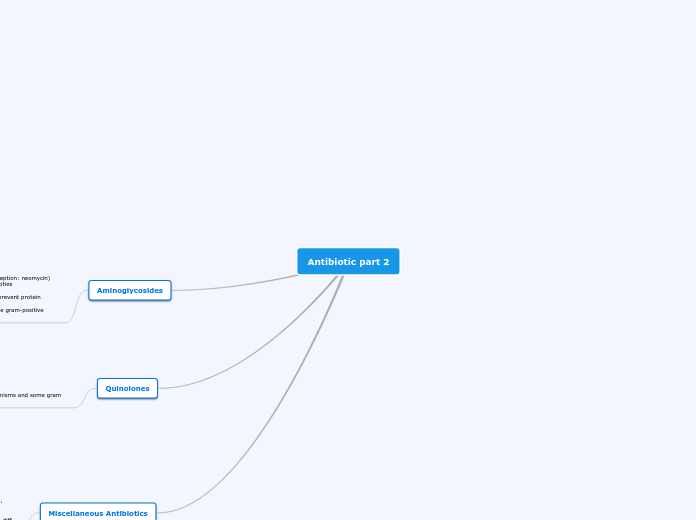作者:kathleen stephenson 6 年以前
327
Antibiotic part 2

作者:kathleen stephenson 6 年以前
327

更多类似内容
Metronidazole (Flagyl) -used for aanaerobic organisms -Intraabdominal and gynecologic infections -Protozoal infections -Several drug interactions
Nitrofuantoin (macrodantin) -Primarily used for UTIs -use carefully if renal function is impaired -Drug concentrates in the urine -May cause fatal hepatotozicity
Quinupristin dalfopristin (synercid) -
mechanism of action: -Bactericidal -Alter DNA of bacteria, causing death -Do not affect human DNA -Used to treat S. aureus, Serratia marcescens, and Mycobacterium fortuitum -Bacterial resistance to quinolone antibiotics: family that includes E. coli
Indications: -Gram negative bacteria such as Pseudomonas -Complicated urinary tract, respiratory, bone and joint, GI, skin, and sexually transmitted infections -Anthrax (ciprofloxacin)
Interactions: -oral quinolones: antacids, calcium, magnesium, iron, zinc preparations, or sucralfate -Patients need to take the interacting drugs at least 1 hour before or after taking quinolones. -Dairy products -Enteral tube feedings -Probenecid -Nitrofuraantoin -Oral anticoagulants
Adverse Effects: CNS; headache, dizziness, insomnia, depression, restlessness, convulsions GI: Nausea, vomiting, diarrhea, constipation, thrush, increased liver function study results, others Cardiac: Prolonged QT interval Integumentary: Rash, pruritus, urticaria, flushing Other: Ruptured tendons, tendonitis, fever chills, blurred vision, tinnitus
Used to kill gram-negative bacteria, such as pseudomonas spp Escherichia coli, proteus spp, klebsiella spp, Serratia spp -often used in combination with other antibiotics for synergistic effects (beta- lactams or vancomycin) -Used for certain gram-positive infections that are resistanct to other antibiotics -Aminoglycosides are poorly absorbed through the GI tract and are given parenterally. -Exception: neomycin >given orally to decontaminate the GI tract before surgical procedures >Also used as an enema for this purpose >Used to treat hepatic encephalopathy
Adverse Effects -Cause serious toxicities >Nephrotoxicity (renal damage) >Ototoxicity (auditory impairment and vestibular impairment (8th cranial nerve) -Must monitor drug levels to prevent toxicities -Minimum inhibitory concentration (MIC) -Therapeutic drug monitoring -Ototoxicity and nephrotoxicity are the most significant -Headache -Paresthesia -Fever -Superinfections -Vertigo -Skin rash -Dizziness
Therapeutic Drug Monitoring -Serum levels measured to prevent toxicity -Serum level needs to be at least eight times higher than the MIC -Time dependent killing -Concentration dependent killing -Peak: highest drug levels for once daily regimens -Trough: lowest to ensure adequate renal clearance of the drug and avoid toxicity -Postantibiotic effects -Resistance -Drug interactions